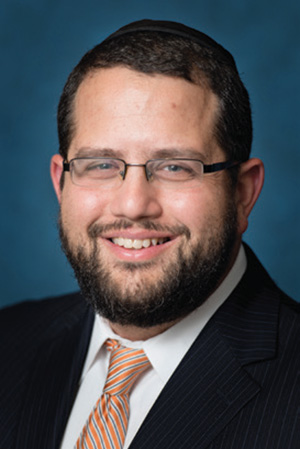

Every day, when I step into my shiur room, I pray that I am able to inspire my talmidim to absorb and inculcate the Torah we learn together. As mechanchim, teachers and as parents, we are constantly bombarded with the latest fads and theories in education or parenting that will be the trick to unlock our students’/children’s potential. However, if we take a step back as we enter into Shavuot and reflect on how Torah was first taught, we can glean tremendous insight into methods of transmitting our precious mesorah as parents and teachers.
Many times throughout my career in chinuch I have seen boys who in the classroom sit and mindlessly take notes in shiur in order to memorize those notes, and then soon after the test expunge them from their memory. Unfortunately, these are also often the same boys who are not religiously inspired. Why are these boys not inspired? Obviously there could be multiple reasons, and we shouldn’t be naive that there is one “silver bullet” to inspire our youth. However, when we look at how Hashem presented klal Yisrael with the Torah it gives us some fresh (yet old) perspectives on teaching Torah.
The pasuk in Parshat Yitro says,
וְכָל־הָעָם֩ רֹאִ֨ים אֶת־הַקּוֹלֹ֜ת וְאֶת־הַלַּפִּידִ֗ם וְאֵת֙ ק֣וֹל הַשֹּׁפָ֔ר וְאֶת־הָהָ֖ר עָשֵׁ֑ן וַיַּ֤רְא הָעָם֙ וַיָּנֻ֔עוּ וַיַּֽעַמְד֖וּ מֵֽרָחֹֽק׃
All the people witnessed the thunder and lightning, the blare of the horn and the mountain smoking; and when the people saw it, they fell back and stood at a distance.
What does it mean that they saw the thunder? The Sfas Emes (The Gerrer Rebbe, R’ Yehudah Aryeh Leib Alter) explains that they felt the Torah being given to them with every ounce of their being. They were presented with the Torah in a way that it moved them physically and emotionally. In order for our children to learn in a way that inspires them it must be presented in a very real way to get them involved and physically engaged, not just passive bodies sitting behind a desk listening to someone talk at them for hours on end. So many of our children are not pure auditory learners who just absorb information being lectured to them while they take notes. The morning blessing on the Torah is not to learn Torah—it is to be involved, engaged in Torah. Torah learning has to engage the body, mind and soul for it be long-lasting and effective. There is a difference between having our children being taught and their learning. Our rebbeim and teachers need to teach in a way that reaches our children’s soul and inspires them to greatness and inspires them to learn because they want to and not just be taught.
When parenting our children, it is crucial that parents keep in mind that the way our children learn to love Judaism and love learning is when we learn Torah and do mitzvot like we were at Har Sinai, and we show them that we are just as inspired—and not by giving lectures and telling them what to do. In Yiddish there is a phrase “to learn with a brehn,” that is to learn with a fire, or in our context, thunder and lightning. If our children or students see us learning and doing mitzvot with a brehn they are much more likely to do so as well.
This is related to a second understanding of our pasuk: what does it mean that the Jews saw thunder at Har Sinai? The Degel Machane Ephraim (Rabbi Moshe Chaim Ephraim of Sudilkov, grandson of the Baal Shem Tov) explains that the “sounds” the Bnei Yisrael heard weren’t just thunder; it was as if they were all of a sudden able to appreciate the sweet sounds (kolot) of Torah being learned. When I was in Yeshiva College I took a class in appreciating classical orchestra music. For me, who is not musical at all, it was literally the hardest class I took in college. When the professor would say to me, “Don’t you hear the cadence?” I would look at him like he was speaking a foreign language; it was totally lost on me. However, I had a friend who had been writing his own sheet music since high school and who could hear and appreciate every nuance of the music. He would tutor me for hours until I could begin to hear the nuances just a little.
Many of us are unfortunately like this with Torah learning as well. There are those of us who appreciate it a little, but are not invested in it like my friend was in his music, and, therefore, we don’t appreciate or enjoy it. At Har Sinai, the Jews all of sudden shook off the constraints of slavery and became a nation of kohanim; they were able to pick the spiritual nuances of the world and truly appreciate the beauty of Torah even though they had so little exposure to it. We do not need to be great Torah scholars or very righteous people to inspire our children to spiritual greatness. We need to try to sensitize ourselves to its greatness and to push ourselves to pick up its subtle messages. In the morning Torah blessing we also pray to God that the Torah should be “sweet.” We need to pray for this because it doesn’t necessarily come automatically; we need to work on ourselves to appreciate it. When we pass on a message to our children that Torah is sweet, even if we are are not so sensitive to it it’s not hypocritical—it is sharing our hopes and dreams with them that we want them to achieve greatness.
By Rabbi Shimon Schenker
Rabbi Shimon Schenker is the associate principal at YUHSB/MTA.










